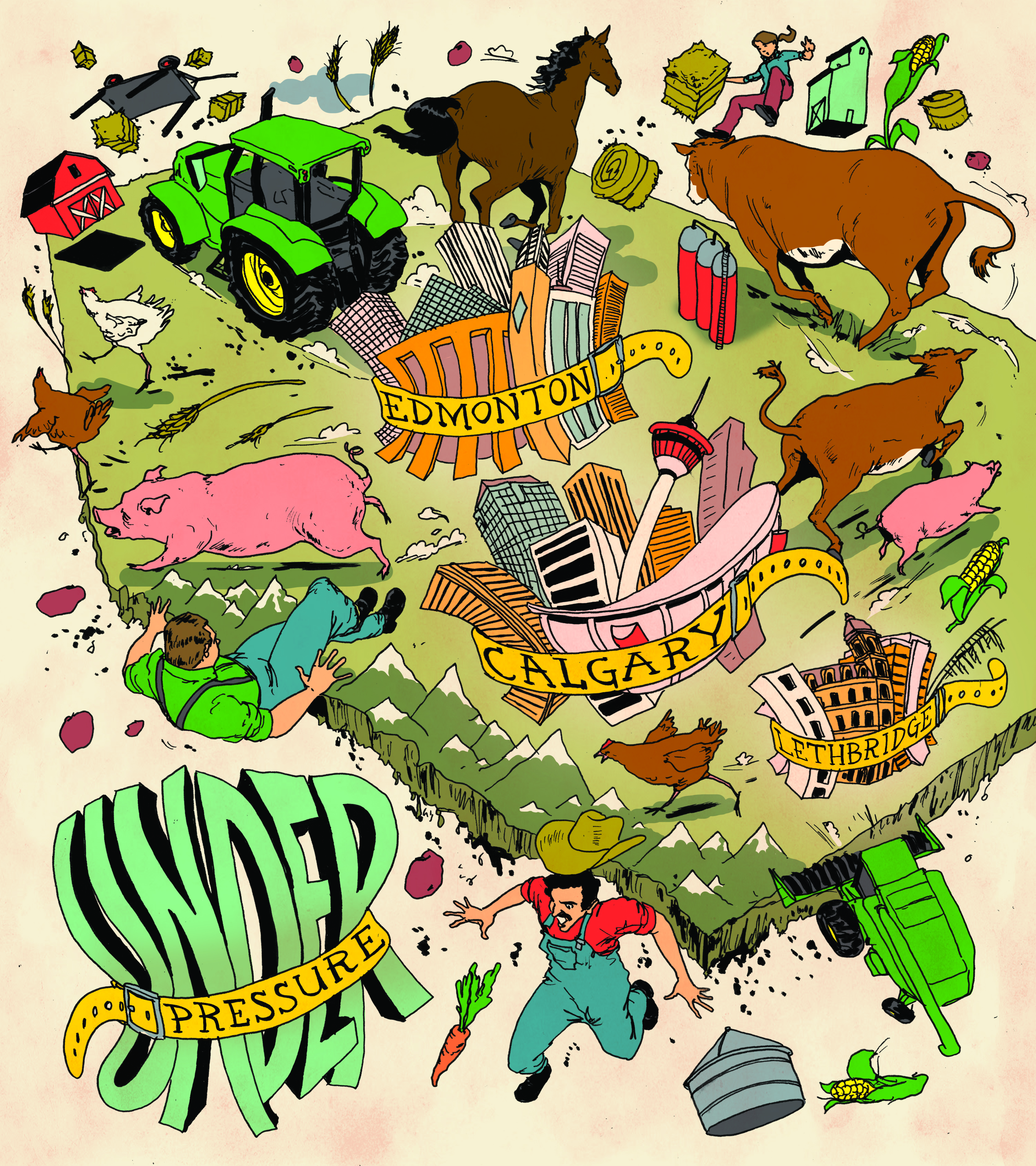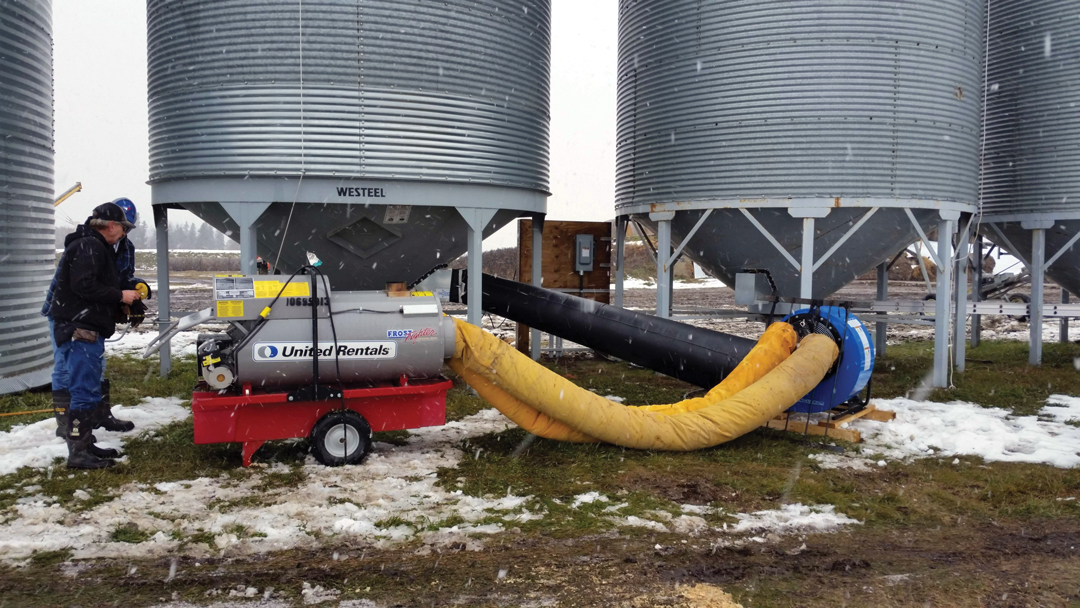UNDER PRESSURE
RURAL ALBERTA’S FIGHT AGAINST URBAN SPRAWL
BY TAMARA LEIGH
It is four kilometres from David and Barb Wedman’s farm to the south edge of the City of Edmonton’s corporate limit. When the family homestead was first settled in 1892, the city was a full day’s travel away. Five generations later, irritated commuters crowd the Wedmans’ farm equipment on the roads as they rush to town.
“We know the urban sprawl is coming eventually because we’re close to the city, but my land is not for sale until I am ready to sell it,” said David Wedman.
The Wedman farm is part of the 38,500 acres that the City of Edmonton is proposing to annex from Leduc County. If the annexation is successful, the city will have enough space for another 50 years of urban growth. It will push gradually out into residential and commercial development, scraping some of the best crop-producing topsoil in Canada off the land as it goes.
“Where they want to do this urban sprawl is the majority of the good land. Let’s sprawl to where the farmers struggle to make a living,” said Barb Wedman. “We are not so steadfast that we don’t appreciate what we have around us, but in Alberta we don’t have a protected land base. Nobody ever thought we’d need to protect this black soil.”
The loss of agricultural land is an increasingly common story in Canada and around the world. Over half the world’s population lives in cities, but all of those people still need to eat. Lenore Newman, PhD, is the Canada Research Chair in food security and environment at the University of the Fraser Valley in Chilliwack, B.C.
“We are entering a period of food crisis around the world, and Canada is one of the few places that still has underutilized farmland,” Newman explained. “That means we haven’t had the conversation about whether or not we should be losing farmland.”
Newman pointed to California to illustrate her point.
“California is in crisis. Ninety per cent of the state is in severe drought, and 70 per cent is extreme. In Canada, we import $1.8 billion of California produce every year, and this summer it’s going to run out,” she said.
California doesn’t just dominate the produce section at the grocery store, it’s also a cautionary tale about what happens when urban sprawl goes unchecked. In the early days of Los Angeles, farms and orange orchards surrounded the city. Today, agriculture has been erased from the landscape—13,000 square kilometres of fertile land subsumed by urban growth.
Across North America, cities are trying different models to safeguard the surrounding agricultural lands with varied results. Toronto has the “green belt,” Portland has set an urban growth boundary, and Vancouver is limited by B.C.’s Agricultural Land Commission, which restricts residential and commercial development on agricultural land.
“When you are located on a plain, it takes incredible fortitude to form a ring around a city and say, ‘no more.’ In the U.S., a lot of cities on the plains have a ring road and outer ring road because it is so easy to keep jumping the boundary,” said Newman about the challenges facing prairie cities like Calgary and Edmonton.
All along the Highway 2 corridor from Edmonton to Calgary, land is being bought for speculation and development. It is driving land prices higher, and gradually converting agricultural land to other uses.
According to Farm Credit Canada (FCC), agricultural land values have increased every year since 1992. The price of agricultural land across Alberta was up by 12.9 per cent last year. Nationally, the average increase was 22.1 per cent—the highest since FCC started tracking in 1985.
“The main drivers for land values are location and supply and demand. If there’s a sector that’s not active, prices won’t go up,” explained Kenneth Gurney, senior appraiser for FCC in Alberta. “In the Highway 2 corridor, oil and gas is strong, the urban influence is strong and agriculture is strong, so the values keep going up.”
Over the last couple of years, good crops and high prices have helped keep agriculture competitive for land use, but the pressure keeps building for land on the urban fringe.
“You can’t argue that agricultural land is not being swallowed by urbanization, particularly along the Highway 2 corridor and the edge of major centres,” said Jason Cathcart, land-use policy manager with Alberta Agriculture and Rural Development.
From 1996 to 2009, approximately 200,000 acres were permanently lost by agriculture, said Cathcart, 90 per cent of which was between Edmonton and Calgary. Ninety-five per cent of that development is on Class 2 and 3 soils, some of Alberta’s most productive cropland. Cathcart estimated that roughly an equal amount of land has been temporarily lost to industrial uses, but could eventually be reclaimed and brought back into production.
Getting hard numbers is difficult because the data is incomplete. The provincial government tracked the loss of agricultural land from the 1970s until 1995, when the Municipal Government Act granted autonomy to municipalities to make decisions about land use. The provincial land use plan that accompanies the Act provides high-level direction to municipalities with recommendations to identify their agricultural lands and zone them accordingly; limit fragmentation and conversion; direct development away from agricultural lands; and limit conflicts between intensive agriculture and non-agricultural uses.
“There has been no provincial oversight, monitoring or knowledge as to how well municipalities have been doing since 1995,” said Cathcart. “Then, during the last boom cycle in the mid-2000s, the province started to hear the public asking what we were doing for public planning for land in the province. Up until then, the province took private property interests to the extreme.”
Without a coherent, legislated agriculture policy, urban municipalities are left to navigate through networks of regional planning boards, inter-municipal development plans and other tools to try to fill the void. As the City of Edmonton continues to grow, two major principles guide their efforts.
“We are working to reduce our footprint and be efficient in the use of infrastructure dollars and infrastructure,” said Tim Brockelsby, senior planner in urban planning and environment for the City of Edmonton. “In the big scheme, to have those principles applied preserves agricultural land by being more efficient.
“As planners, we need to look ahead, but there’s a general acceptance that there will be growth,” he added. “With the annexation or within the existing city boundaries, ultimately it comes down to the land owner making a choice around this issue.”
Janelle Hebert could not disagree more. She returned to her family’s farm, Riverbend Gardens, with her husband in 2006 to grow vegetables for the local market and raise a family. The land was part of an area annexed into the City of Edmonton in 1981. A couple of years after they arrived, an area structural plan (ASP) was presented to the city council to begin development in the area.
“I think the spin of leaving agricultural land in the farmers’ hands is the wrong one,” said Hebert, after six years of negotiating with the council and developers. “It’s not up to me. You can’t leave it in the hands of the people who are struggling to make it because it makes it so easy to walk away.”
Hebert and other farmers worked with the City to have the land designated for agriculture, but when the province asked to have a provincial highway included in the ASP, the developers ran it through the middle of the farmland. The farmers say the City could save their farms by redirecting the highway, but the developers don’t want it on their land, either.
“Some of the farmers want to cash out and have been waiting for it for 30 years. Some of us who have really viable businesses are hanging on and saying, ‘let’s make agriculture part of development,’” she said. “If I cash out, I take this away from the future generations. It’s a one-time payout and it’s over. This kind of development and politics is really shortsighted. The value of agricultural land is priceless in the long term.”






Comments